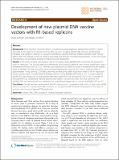Development of new plasmid DNA vaccine vectors with R1-based replicons
Author(s)
Bower, Diana Morgan; Prather, Kristala L. Jones
Download1475-2859-11-107.pdf (884.1Kb)
PUBLISHER_CC
Publisher with Creative Commons License
Creative Commons Attribution
Terms of use
Metadata
Show full item recordAbstract
Background:
There has been renewed interest in biopharmaceuticals based on plasmid DNA (pDNA) in recent years due to the approval of several veterinary DNA vaccines, on-going clinical trials of human pDNA-based therapies, and significant advances in adjuvants and delivery vehicles that have helped overcome earlier efficacy deficits. With this interest comes the need for high-yield, cost-effective manufacturing processes. To this end, vector engineering is one promising strategy to improve plasmid production.
Results:
In this work, we have constructed a new DNA vaccine vector, pDMB02-GFP, containing the runaway R1 origin of replication. The runaway replication phenotype should result in plasmid copy number amplification after a temperature shift from 30°C to 42°C. However, using Escherichia coli DH5α as a host, we observed that the highest yields of pDMB02-GFP were achieved during constant-temperature culture at 30°C, with a maximum yield of approximately 19 mg pDNA/g DCW being observed. By measuring mRNA and protein levels of the R1 replication initiator protein, RepA, we determined that RepA may be limiting pDMB02-GFP yield at 42°C. A mutant plasmid, pDMB-ATG, was constructed by changing the repA start codon from the sub-optimal GTG to ATG. In cultures of DH5α[pDMB-ATG], temperature-induced plasmid amplification was more dramatic than that observed with pDMB02-GFP, and RepA protein was detectable for several hours longer than in cultures of pDMB02-GFP at 42°C.
Conclusions:
Overall, we have demonstrated that R1-based plasmids can produce high yields of high-quality pDNA without the need for a temperature shift, and have laid the groundwork for further investigation of this class of vectors in the context of plasmid DNA production.
Date issued
2012-08Department
Massachusetts Institute of Technology. Department of Chemical EngineeringJournal
Microbial Cell Factories
Publisher
BioMed Central Ltd
Citation
Bower, Diana M, and Kristala LJ Prather. “Development of New Plasmid DNA Vaccine Vectors with R1-based Replicons.” Microbial Cell Factories 11.1 (2012): 107.
Version: Final published version
ISSN
1475-2859